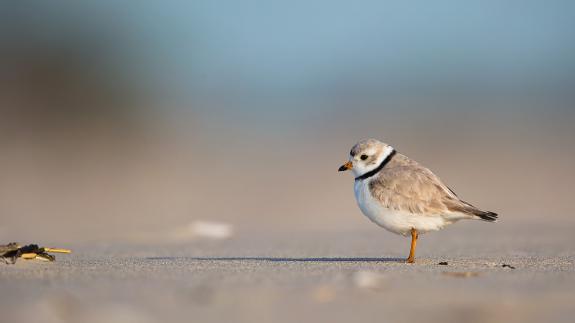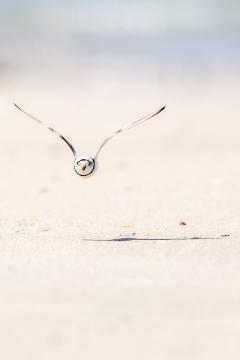Piping Plover
The Piping Plover (Charadrius melodus) population declined in 2013 to only 108 pairs. They are listed as an endangered species under the New Jersey Endangered and Nongame Species Conservation Act.
 Piping plovers are listed as endangered in New Jersey. © Northside Jim
Piping plovers are listed as endangered in New Jersey. © Northside Jim
It’s that time of year again! Piping plovers(Charadrius melodus) are back on New Jersey beaches sitting on their nests and raising their newly hatched chicks!
Piping plovers are small shorebirds with a black neck band and a black bar across the forehead. The upperparts are light sandy-brown and the underparts are white, providing camouflage against the sandy beach. They have orange legs and an orange and black beak. Piping plovers feed on marine worms, small crustaceans, mollusks, and some insects.
Piping plovers breed on NJ barrier islands and beaches from Sandy Hook toCape May. In late March and April, piping plovers begin arriving. Males use aerial displays to establish territories and call to mark boundaries and attract mates. The male digs numerous nests (scrapes) throughout his territory by kicking up sand with his back legs until the female selects the right scrape. Plovers exhibit fidelity to nesting sites, and may return to a previously successful area the next year (s).
During April and May, female piping plovers lay 3 to 4 sand-colored eggs which both parents incubate for about 27 days. If a nest is destroyed early in the season by floods or predators, the pair will re-nest, sometimes several in a season.
 Zoom+ A two day old piping plover. © Northside Jim
Zoom+ A two day old piping plover. © Northside Jim
The newborn chicks are tiny, white, and downy. They leave the nest within a few hours of hatching. Able to walk right away, the chicks follow their parents in search of food.
When predators or intruders come close, chicks squat motionless on the sand while the parents attempt to distract intruders by pretending to have a broken wing. Both parents care for the chicks for 3 to 4 weeks. Chicks are able to fly at 25-35 days and fledge from late June to mid-August.
In addition to nesting birds, many plovers migrate south along the Atlantic seaboard, over-wintering in the Southeast U.S. and theBahamas. Migrants can be seen inNew Jerseyfrom early March to late April and again from mid-July to the end of October. Females are the first to leave the breeding grounds, followed by males, then juveniles.
Far less is known about the wintering sites used by piping plovers, even though they spend at least half their lives on the wintering grounds. Over the past five years the importance of theBahamasas a major wintering site for piping plovers has become increasingly evident. CWF has played an integral role in shedding light on their wintering habitats and threats. CWF also works to raise awareness and provide education to the general public and school children in theBahamasand inNew Jersey.
New Jersey’s piping plover breeding population has averaged about 120 pairs since they were federally listed as threatened species in 1986. Unfortunately, their numbers have dropped in recent years, with 108 pairs in 2013. Unlike their federal designation, piping plovers are listed as ‘endangered’ under the NJ Endangered and Nongame Species Conservation Act.
 Zoom+ Piping plover in flight. © Northside Jim
Zoom+ Piping plover in flight. © Northside Jim
Threats to piping plovers include loss of habitat from development; predation by red fox, raccoons, feral or free-roaming cats, gulls and crows; flooding from storms; disturbance from beach recreation activities such as vehicles, dogs, kite flying and kite surfing; and disturbance from incompatible beach management practices such as beach raking, vehicle use, moving of sand, and overplanting of beach grass; and climate change including sea-level rise.
CWF manages piping plovers on the ground by posting fencing and education signage around nests each breeding season. Once biologists locate nests, we typically provide them with a special enclosure that keeps predators out.
Seasonal biologists, interns, and volunteers also regularly patrol the nesting sites to help beachgoers understand why access to some portions of the beach and certain activities, such as dog walking, are restricted to protect piping plovers.
So while you are at the beach this summer, keep your eyes peeled for these enjoyable critters. And look for the steps we take to protect them!
by Stephanie Egger, CWF Wildlife Biologist
Find Related Info: Beach Nesting Birds






